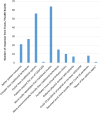The use of computer-aided design and manufacture for foot orthoses: A cross-sectional study of orthotic services in the UK
- PMID: 39909864
- PMCID: PMC11798744
- DOI: 10.1002/jfa2.70031
The use of computer-aided design and manufacture for foot orthoses: A cross-sectional study of orthotic services in the UK
Abstract
Objective: This study aimed to identify how computer aided design and manufacture (CAD/CAM) technologies are currently being used for insole production by UK orthotic services in the National Health Service (NHS), including any variation in the specific processes and identify barriers to implementation.
Design: A cross-sectional study was undertaken using freedom of information requests sent to all 214 NHS Trusts and Health Boards (HBs) across the UK. The request comprised 22 questions relating to CAD/CAM for insole production by UK NHS orthotic services during the 2021/22 financial year.
Outcome measures: Analysis was undertaken and presented in terms of response rate to individual questions. Where free text responses were provided, thematic analysis was conducted.
Results: Responses were received from 186 (86.9%) Trusts/HBs, those who did not have an orthotic service were excluded, and 131 responses were included in the final analysis. 70.5% (91/129) of Trusts/HBs used CAD/CAM to manufacture bespoke insoles. The most common workflow associated with CAD/CAM insole production was foot-shape capture with a foam box impression cast (86.8% (79/91)); casts transported to another site (90.8% (79/87)); foam boxes scanned into a CAD/CAM system (81.6% (71/87)); insoles designed by a technician (73.6% (67/91)) and insole produced with reduction milling (59.1% (SD 37.92)). The greatest barriers to the use of CAD/CAM were those of equipment costs and staff experience and training.
Conclusions: UK orthotic services have widely adopted CAD/CAM insole production, but fully-digital workflow is uncommon. Hybrid-digital workflow involves physical casts and their transportation, generating waste and impacting sustainability. Further research is required to understand how hybrid-digital and fully-digital workflow affect patient treatment outcomes, costs and sustainability. Barriers to CAD/CAM including costs and staff training which should be considered alongside the growing body of research around CAD/CAM technologies.
Keywords: CAD/CAM; foot orthoses; insoles; orthotics.
© 2025 The Author(s). Journal of Foot and Ankle Research published by John Wiley & Sons Australia, Ltd on behalf of Australian Podiatry Association and The Royal College of Podiatry.
Conflict of interest statement
The authors declare no conflicts of interest.
Figures






References
-
- Mendes, A. A. M. T. , de Almeida Silva H. J., Costa A. R. A., Pinheiro Y. T., de Almeida Lins C. A., and de Souza M. C.. 2020. “Main Types of Insoles Described in the Literature and Their Applicability for Musculoskeletal Disorders of the Lower Limbs: A Systematic Review of Clinical Studies.” Journal of Bodywork and Movement Therapies 24(4): 29–36. 10.1016/j.jbmt.2020.06.001. - DOI - PubMed
-
- Binedell, T. , Subburaj K., Wong Y., and Blessing L. T. M.. 2020. “Leveraging Digital Technology to Overcome Barriers in the Prosthetic and Orthotic Industry: Evaluation of its Applicability and Use during the COVID‐19 Pandemic.” JMIR Rehabilitation and Assistive Technologies 7(2): e23827. 10.2196/23827. - DOI - PMC - PubMed
-
- Smith, D. G. , and Burgess E. M.. 2001. “The Use of CAD/CAM Technology in Prosthetics and Orthotics‐‐Current Clinical Models and a View to the Future.” Journal of Rehabilitation Research and Development 38(3). - PubMed
MeSH terms
Grants and funding
LinkOut - more resources
Full Text Sources
Miscellaneous

